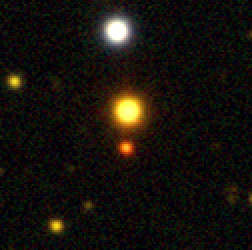Top Qs
Timeline
Chat
Perspective
UScoCTIO 108
Binary star system From Wikipedia, the free encyclopedia
Remove ads
UScoCTIO 108 is a binary system, approximately 470 light-years away in the Upper Scorpius (USco) OB association. The primary, UScoCTIO 108A, with mass around 0.06 solar masses, is a brown dwarf or low-mass red dwarf. The secondary, UScoCTIO 108B, with a mass around the deuterium burning limit of 13 Jupiter masses, would be classified as either a brown dwarf or an extrasolar planet.[2]
The primary component of the system was discovered in 2000 as a possible member of the Upper Scorpius association, based on its position in a HR diagram, in a search for new member of the association by the Cerro Tololo Inter-American Observatory (CTIO), where it received the designation UScoCTIO 108.[6] Later, spectroscopic and photometric observations confirmed that the object is a real member of the association, showing signs of low gravity and youth, and estimated a mass of 60 times the mass of Jupiter (MJ), an effective temperature of 2,800 K and a spectral type of M7. The low mass indicates that the object is not able to sustain hydrogen fusion, making it a brown dwarf.[2]
The secondary member of the system was found in 2008 as an object located at a separation of 4.6 arcseconds, which corresponds to a physical separation of more than 670 AU, and is also a confirmed member of the Upper Scorpius association.[2] Its spectrum shows it is also a cold substellar object, with an effective temperature of 2,300 K and a spectral type of M9.5.[4] Its mass was originally estimated at 14 MJ,[2] very close to the nominal boundary between planets and brown dwarf, but a recent revision of the age of the Upper Scorpius association to 11 million years increased this value to 16 MJ, indicating that the object is likely a low mass brown dwarf.[7] The physical association between the two brown dwarfs has not been confirmed by observation of common proper motion, but is considered very likely given the proximity between them.[2][3]
The minimum separation between the two brown dwarfs, 670 AU, is much larger than the mean of other similar mass systems, and indicates that the pair (if they really form a binary system) is very weakly bound, with an escape velocity for the secondary component of only 0.4 km/s. Considering the average stellar density in an association like Upper Scorpius, it is estimated that perturbations by passing stars will cause the rupture of the system in a few million years.[2]
Observations by the infrared telescope WISE revealed excess emission at 12 and 22 μm, indicating the presence of a debris disk around the brown dwarf.[8]
Remove ads
See also
References
External links
Wikiwand - on
Seamless Wikipedia browsing. On steroids.
Remove ads


